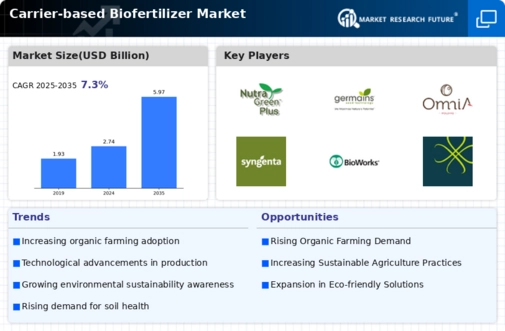Government Support and Regulations
Government policies and regulations play a crucial role in shaping the Global Carrier-based Biofertilizer Market Industry. Many countries are implementing supportive measures, such as subsidies and grants, to encourage the use of biofertilizers. These initiatives aim to reduce chemical fertilizer dependency and promote sustainable agricultural practices. For instance, various agricultural departments worldwide are actively promoting biofertilizers through educational programs and financial incentives. This regulatory support is expected to propel the market, with projections indicating a growth trajectory that could see the market value reach 5.97 USD Billion by 2035, highlighting the importance of governmental influence in the sector.
Market Trends and Growth Projections
The Global Carrier-based Biofertilizer Market Industry is poised for robust growth, with projections indicating a market value of 2.74 USD Billion in 2024 and an anticipated rise to 5.97 USD Billion by 2035. The compound annual growth rate (CAGR) of 7.33% from 2025 to 2035 highlights the increasing adoption of biofertilizers in various agricultural sectors. This growth is driven by factors such as rising organic farming practices, government support, and technological advancements. The market trends suggest a shift towards sustainable agricultural practices, reflecting a broader global commitment to environmental stewardship and food security.
Increasing Demand for Organic Farming
The Global Carrier-based Biofertilizer Market Industry experiences a notable surge in demand driven by the rising popularity of organic farming practices. As consumers become more health-conscious and environmentally aware, the shift towards organic produce is evident. This trend is supported by various government initiatives promoting sustainable agriculture, which further enhances the market's growth. In 2024, the market is projected to reach 2.74 USD Billion, reflecting the increasing adoption of biofertilizers as a viable alternative to chemical fertilizers. This shift not only benefits soil health but also aligns with global sustainability goals, indicating a robust future for the industry.
Rising Awareness of Environmental Sustainability
The growing awareness of environmental sustainability among farmers and consumers is a significant driver for the Global Carrier-based Biofertilizer Market Industry. As the adverse effects of chemical fertilizers on soil health and ecosystems become more apparent, there is a shift towards eco-friendly alternatives. This awareness is fostering a demand for biofertilizers that enhance soil fertility without harming the environment. Educational campaigns and outreach programs by agricultural organizations are further promoting the benefits of biofertilizers. This shift in mindset is likely to sustain market growth, as more stakeholders recognize the long-term advantages of adopting biofertilizers in their agricultural practices.
Global Population Growth and Food Security Concerns
The increasing global population and the corresponding need for food security are driving the Global Carrier-based Biofertilizer Market Industry. With the world population projected to reach approximately 9.7 billion by 2050, the demand for sustainable agricultural solutions is more pressing than ever. Biofertilizers offer a means to enhance crop productivity while minimizing environmental impact. Governments and agricultural bodies are focusing on sustainable practices to ensure food security, which includes the adoption of biofertilizers. This urgent need for sustainable food production methods positions the biofertilizer market for substantial growth, as stakeholders seek effective solutions to meet the challenges of feeding a growing population.
Technological Advancements in Biofertilizer Production
Technological innovations are significantly impacting the Global Carrier-based Biofertilizer Market Industry, enhancing production efficiency and product efficacy. Advances in microbial technology and formulation processes are leading to the development of more effective biofertilizers that cater to diverse agricultural needs. For instance, the integration of nanotechnology in biofertilizer formulations has shown promising results in improving nutrient delivery and uptake by plants. These advancements not only increase crop yields but also contribute to sustainable farming practices. As the industry evolves, the anticipated compound annual growth rate (CAGR) of 7.33% from 2025 to 2035 underscores the potential for growth driven by technological progress.




















Leave a Comment